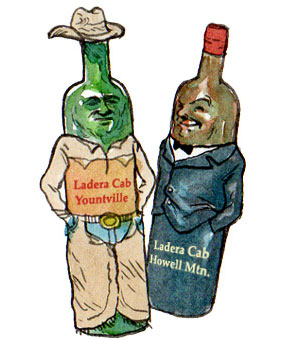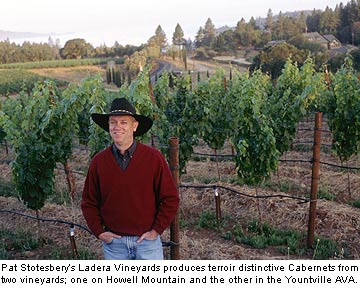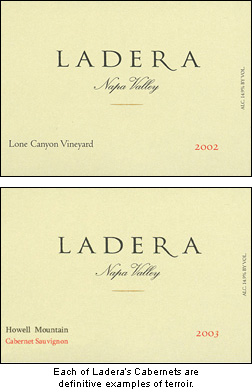

The personalities of Ladera’s Cabernets are as different as their origins, from opposite ends of the Napa Valley.
Howell Mountain ~ Napa Valley (AVA)
Talking Terroir with Pat Stotesbery of Ladera
"Some people love the elegance of the Howell Mountain and others the dark tannins of the Lone Canyon. If you would blend them together, you’d lose that sense of place."
by
Alan Goldfarb
September 13, 2006
Alan Goldfarb (AG): Why make wines from two different areas?
Pat Stotesbery (PS): It makes for a great story, and in my case, this concept is a great example between soil and climate and what it does to wines that are vinified the same. Not too many people are doing that. You can readily identify both.
 AG: The vinification process is exactly the same for both wines?
AG: The vinification process is exactly the same for both wines?
PS: Yes, but Lone Canyon receives a couple of percentage points more of new oak. Because of the tannin, it can use that extra wood. It also comes off the skins a few days earlier in order to control the tannin.
AG: Why do you find it necessary and so compelling a story to show the differences between these wines?
PS: People can really understand how two wines that are made the same – with mountain fruit – can be so different. I happen to be a mountain kind of guy. But I suppose someone could say, “why not have one wine from the valley floor and one from the mountain (to better differentiate them)?”
AG: How many acres on Lone Canyon do you have planted and to what varieties, what clones and which rootstock?
PS: Lone Canyon has 75 acres. The breakdown is 1½ acres of Malbec, 1½ Petit Verdot, and the rest is Cabernet. Oh, there’s also three acres of Syrah, which is a stand-alone to our wine club only.
There are 13 different clones for Cabernet, and seven rootstock varieties.
AG: How about Howell Mountain?
PS: There’s a little more than 75 acres. There’s about 70 acres of Cabernet, two of Petit Verdot, 2½ of Malbec, two of Merlot, and 3½ acres of Sauvignon Blanc.
We have eight Cabernet clones and six rootstocks.
AG: Tell me about the soils at both locations.
PS: Lone Canyon is radically different. It’s chalky, mineral-y, and gravelly. On the other hand, Howell Mountain has red volcanic soils, clay loam, and large rocks. That’s why, when you compare the two wines, the mineral aspects of the Lone Canyon wine get accentuated. And it has 1,600-1,800 foot elevation, while most of Lone Canyon is at about 1,000 feet.
AG: What about your irrigation regimen?
PS: We drip irrigate 4-to-6 gallons once a week, on both.
AG: To compare the two, Karen (Culler) once told me, “Some people love the elegance of the Howell Mountain and others the dark tannins of the Lone Canyon. If you would blend them together, you’d lose that sense of place. It becomes another …”
PS: Another blended wine.
AG: To sum up the difference, Karen also told me, “The Cab and the small amounts of Malbec and Petit Verdot from there, are not easily tamed, nor understood. I’m still trying to figure it out. It makes a pretty big wine and it tends to get too tannic. They tend to be muscle-y wines but they don’t have as much extraction as Howell Mountain. The tannin structure is the biggest difference (between the two). Lone Canyon has dark, berry fruit and herbal characters, while the Howell has silky tannins and brighter fruit.”
...Pat concurred.
~ Alan Goldfarb, Regional Correspondent – Napa Valley
To comment on Alan Goldfarb’s writings and thoughts, contact him at a.goldfarb@appellationamerica.com
Pat Stotesbery (PS): It makes for a great story, and in my case, this concept is a great example between soil and climate and what it does to wines that are vinified the same. Not too many people are doing that. You can readily identify both.
 AG: The vinification process is exactly the same for both wines?
AG: The vinification process is exactly the same for both wines?
PS: Yes, but Lone Canyon receives a couple of percentage points more of new oak. Because of the tannin, it can use that extra wood. It also comes off the skins a few days earlier in order to control the tannin.
AG: Why do you find it necessary and so compelling a story to show the differences between these wines?
PS: People can really understand how two wines that are made the same – with mountain fruit – can be so different. I happen to be a mountain kind of guy. But I suppose someone could say, “why not have one wine from the valley floor and one from the mountain (to better differentiate them)?”
AG: How many acres on Lone Canyon do you have planted and to what varieties, what clones and which rootstock?
PS: Lone Canyon has 75 acres. The breakdown is 1½ acres of Malbec, 1½ Petit Verdot, and the rest is Cabernet. Oh, there’s also three acres of Syrah, which is a stand-alone to our wine club only.
There are 13 different clones for Cabernet, and seven rootstock varieties.
AG: How about Howell Mountain?
PS: There’s a little more than 75 acres. There’s about 70 acres of Cabernet, two of Petit Verdot, 2½ of Malbec, two of Merlot, and 3½ acres of Sauvignon Blanc.
We have eight Cabernet clones and six rootstocks.

AG: Tell me about the soils at both locations.
PS: Lone Canyon is radically different. It’s chalky, mineral-y, and gravelly. On the other hand, Howell Mountain has red volcanic soils, clay loam, and large rocks. That’s why, when you compare the two wines, the mineral aspects of the Lone Canyon wine get accentuated. And it has 1,600-1,800 foot elevation, while most of Lone Canyon is at about 1,000 feet.
AG: What about your irrigation regimen?
PS: We drip irrigate 4-to-6 gallons once a week, on both.
AG: To compare the two, Karen (Culler) once told me, “Some people love the elegance of the Howell Mountain and others the dark tannins of the Lone Canyon. If you would blend them together, you’d lose that sense of place. It becomes another …”
PS: Another blended wine.
AG: To sum up the difference, Karen also told me, “The Cab and the small amounts of Malbec and Petit Verdot from there, are not easily tamed, nor understood. I’m still trying to figure it out. It makes a pretty big wine and it tends to get too tannic. They tend to be muscle-y wines but they don’t have as much extraction as Howell Mountain. The tannin structure is the biggest difference (between the two). Lone Canyon has dark, berry fruit and herbal characters, while the Howell has silky tannins and brighter fruit.”
...Pat concurred.
~ Alan Goldfarb, Regional Correspondent – Napa Valley
To comment on Alan Goldfarb’s writings and thoughts, contact him at a.goldfarb@appellationamerica.com















